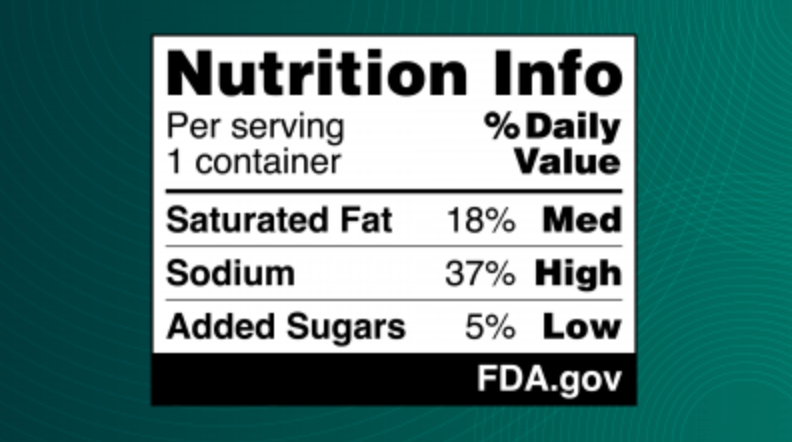FDA Proposes Front-of-Package Nutrition Label to Combat Chronic Disease
A new proposed front-of-package label by the FDA will simplify nutrition information for consumers and encourage healthier food choices
By
Lana Pine
| Published on January 15, 2025
4 min read
Credit: U.S. Food and Drug Administration

The U.S. Food and Drug Administration (FDA) has announced a proposal to implement a front-of-package (FOP) nutrition label for most packaged foods, intended to provide consumers with clear, accessible information about key nutrients linked to chronic diseases — saturated fat, sodium and added sugars.
“The science on saturated fat, sodium and added sugars is clear,” FDA Commissioner Robert M. Califf, M.D, said in a statement. “Nearly everyone knows or cares for someone with a chronic disease that is due, in part, to the food we eat. It is time we make it easier for consumers to glance, grab and go. Adding front-of-package nutrition labeling to most packaged foods would do that.”
According to the U.S. Centers for Disease Control and Prevention (CDC), most Americans consume too much sodium (more than 3,300 milligrams of sodium per day), with most sources coming from processed and restaurant foods. This can in turn raise blood pressure and increase the risk for heart disease. Saturated fats not only raise the risk of heart disease and stroke, they increase the likelihood of weight gain due to excessive calorie consumption. Added sugars, which provide no nutritional value, can also lead to overweight or obesity.
Daily Recommendations:
- Sodium: 2,300 milligrams per day for teens and adults
- Saturated Fat: Less than 10% of your daily calories, while ensuring no more than 25% to 30% of your daily calories come from fats
- Added Sugars: No more than 6% of calories each day. For most Americans, that’s about 100 to 150 calories per day, or about 6 to 9 teaspoons of sugar.
The new Nutrition Info box will use a simple format to label food items with “Low,” “Med,” or “High” levels of these nutrients, complementing the detailed Nutrition Facts label. Although calories would not be included in the box, manufacturers would have the option to provide that information on the front of the package.
With approximately 60% of Americans having one or more chronic diseases, leading to $4.5 trillion in annual health care costs, the goal is to provide consumers with easy-to-understand information and to encourage food manufacturers to reformulate products for better health outcomes.
The initiative is based on extensive research, including a scientific literature review and consumer focus groups. The FDA also conducted an experimental study in 2023 of nearly 10,000 U.S. adults to better understand consumer responses to FOP labels that would allow them to make quick and accurate decisions regarding the healthfulness of the product. Results showed that a black-and-white scheme with percentage daily values was most effective in helping consumers make healthier food choices.
If finalized, manufacturers would be required to add a Nutrition Info box to most packaged foods three years after the effective date for businesses with $10 million or more in annual food sales, and four years for businesses with less than $10 million in annual food sales.
The proposal is part of the FDA’s broader efforts to combat the nation’s chronic disease crisis, including heart disease, diabetes and cancer, and is a key part of the White House’s National Strategy on Hunger, Nutrition and Health to reduce diet-related diseases by 2030.
“Food should be a vehicle for wellness, not a contributor of chronic disease,” FDA Deputy Commissioner for Human Foods Jim Jones said in a statement. “In addition to our goal of providing information to consumers, it’s possible we’ll see manufacturers reformulate products to be healthier in response to front-of-package nutrition labeling. Together, we hope the FDA’s efforts, alongside those of our federal partners, will start stemming the tide of the chronic disease crisis in our country.”

